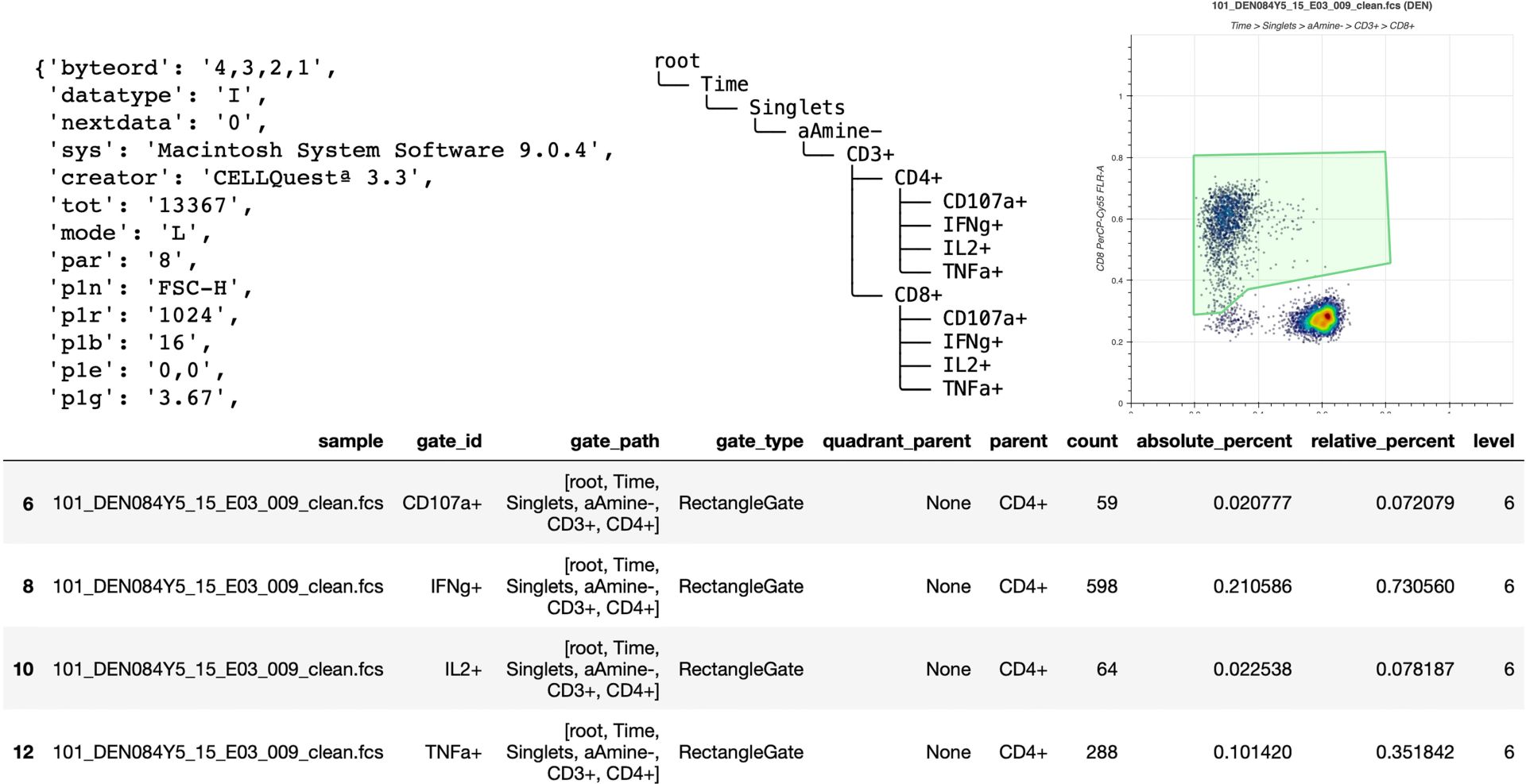- Overview
- Features
- Requirements
- Installation
- Documentation
- Contributing
- Cite FlowKit
- Projects & Research Using FlowKit
FlowKit is a Python toolkit for flow cytometry analysis and visualization, with full support for the GatingML 2.0 standard and limited support for FlowJo 10 workspace files.
- Read / Write FCS Files
- Read FCS files, supporting FCS versions 2.0, 3.0, and 3.1
- Export FCS data as:
- A new FCS 3.1 file
- NumPy array
- Pandas DataFrame
- CSV text file
- Compensation
- Compensate events using spillover matrices from:
- $SPILL or $SPILLOVER keyword value
- FlowJo tab-delimited text
- NumPy array
- GatingML 2.0 spectrumMatrix XML element
- Compensate events using spillover matrices from:
- Transformation
- Logicle
- Inverse hyperbolic sine (ArcSinh)
- FlowJo Bi-exponential
- Hyperlog
- Logarithmic
- Channel ratios
- Linear
- Gating
- Full support for the GatingML 2.0 specification
- Import GatingML XML documents as gating strategies
- Export gating strategies as a valid GatingML XML document
- Support for importing FlowJo 10 workspace files. Workspace imports support the following features:
- Linear, logarithmic, bi-exponential, and logicle transforms
- Polygon, rectangle, ellipse, and quadrant gates
- Exporting a Session as a FlowJo 10 workspace file
- Programmatically create gating strategies including polygon, rectangle, range, ellipsoid, quadrant, and boolean gates
- Retrieve gating results as a Pandas DataFrame
- Full support for the GatingML 2.0 specification
- Visualization
- Histogram of single channel data
- Contour density plot of two channels
- Interactive scatter plot of two channels
- Interactive scatter plot matrix of any combination of channels
- Interactive scatter plots of gates with sample events
FlowKit supports Python version 3.7 or above. All dependencies are installable via pip, and are listed below.
NOTE: FlowUtils uses C extensions for significant performance improvements. For most platforms and Python versions, pre-built binaries are available in PyPI (i.e. installable via
pip).If a pre-built binary of FlowUtils is not available for your environment, the C extensions must be compiled using the source package. NumPy >=1.19 must be installed prior to compiling FlowUtils. If compiling using
gcc, version 5 or later is required.
Required Python dependencies:
- flowio == 1.1.0
- flowutils == 1.0.0
- anytree >= 2.6
- bokeh >= 2, <3.0
- lxml >= 4.4
- matplotlib >= 3.1
- networkx >= 2.3
- numpy >= 1.20
- pandas >= 1.1
- psutils >= 5.8
- scipy >= 1.3
- seaborn >= 0.11, <0.12
NOTE: For macOS users running on Apple Silicon, the version of
pipmay need to be upgraded prior to installing FlowKit in order to install the required dependencies.
pip install flowkit
Clone the repository and ensure pip is up-to-date. It is recommended to use pip to install requirements as relying on setuptools may result in incompatible dependency versions.
git clone https://github.com/whitews/flowkit
cd flowkit
pip install --upgrade pip
pip install -r requirements.txt
python setup.py install
The FlowKit API documentation is available on ReadTheDocs here. The tutorial notebooks in the docs/notebooks directory are a great place to get started with FlowKit, and are linked below.
If you have any questions about FlowKit, find any bugs, or feel something is missing from the tutorials below please submit an issue to the GitHub repository here.
Changelogs for versions are available here
The series of Jupyter notebook tutorials can be found in the docs/notebooks directory of this repository. Note, the interactive scatterplots do not render on GitHub. The rendered versions are available on our documentation page here. Or, clone the repo and run them locally to see the fully interactive plots.
- Part 1 - Sample Class
- Part 2 - transforms Module & Matrix Class
- Part 3 - GatingStrategy & GatingResults Classes
- Part 4 - gates Module
- Part 5 - Session Class
Below are more advanced and practical examples for using FlowKit. If you have an example you would like to submit for consideration in this list (preferably with data), please submit an issue.
- Compare mean fluorescence intensity (MFI) in gated populations
- Customize gate for a single Sample in a Session sample group
- Importing a FlowJo 10 WSP file & replicating analysis in FlowKit
- Dimension reduction on gated populations
- Comparison between Leiden & Louvain clustering
Want to get involved in the development of FlowKit?
Read our CONTRIBUTING guidelines
The following projects and publications have utilized FlowKit. If you have a package or publication where FlowKit was used, and you want it listed here, feel free to submit an issue letting me know.
- Rendeiro, André F et al. "Profiling of immune dysfunction in COVID-19 patients allows early prediction of disease progression." Life science alliance vol. 4,2 e202000955. 24 Dec. 2020, doi:10.26508/lsa.202000955

